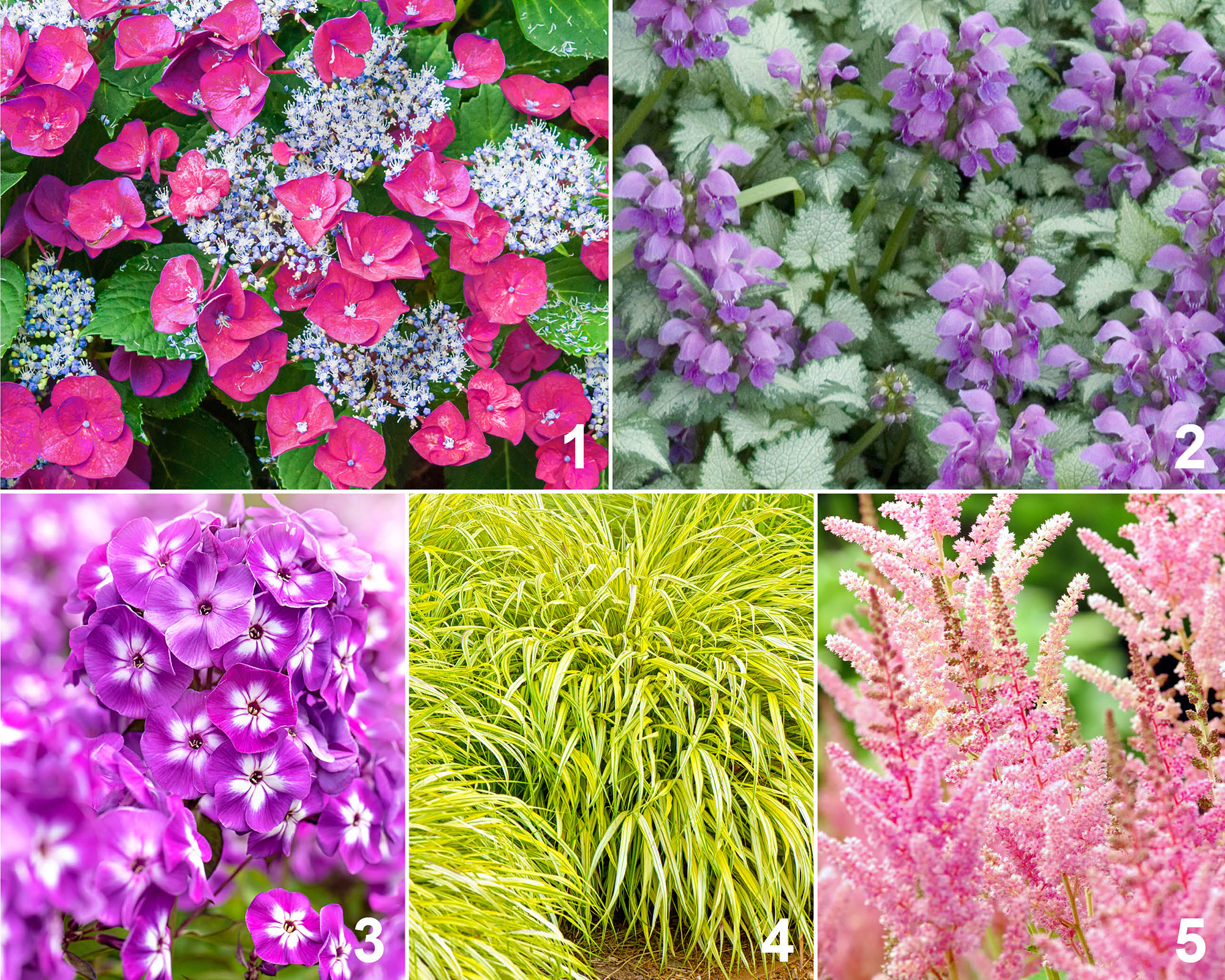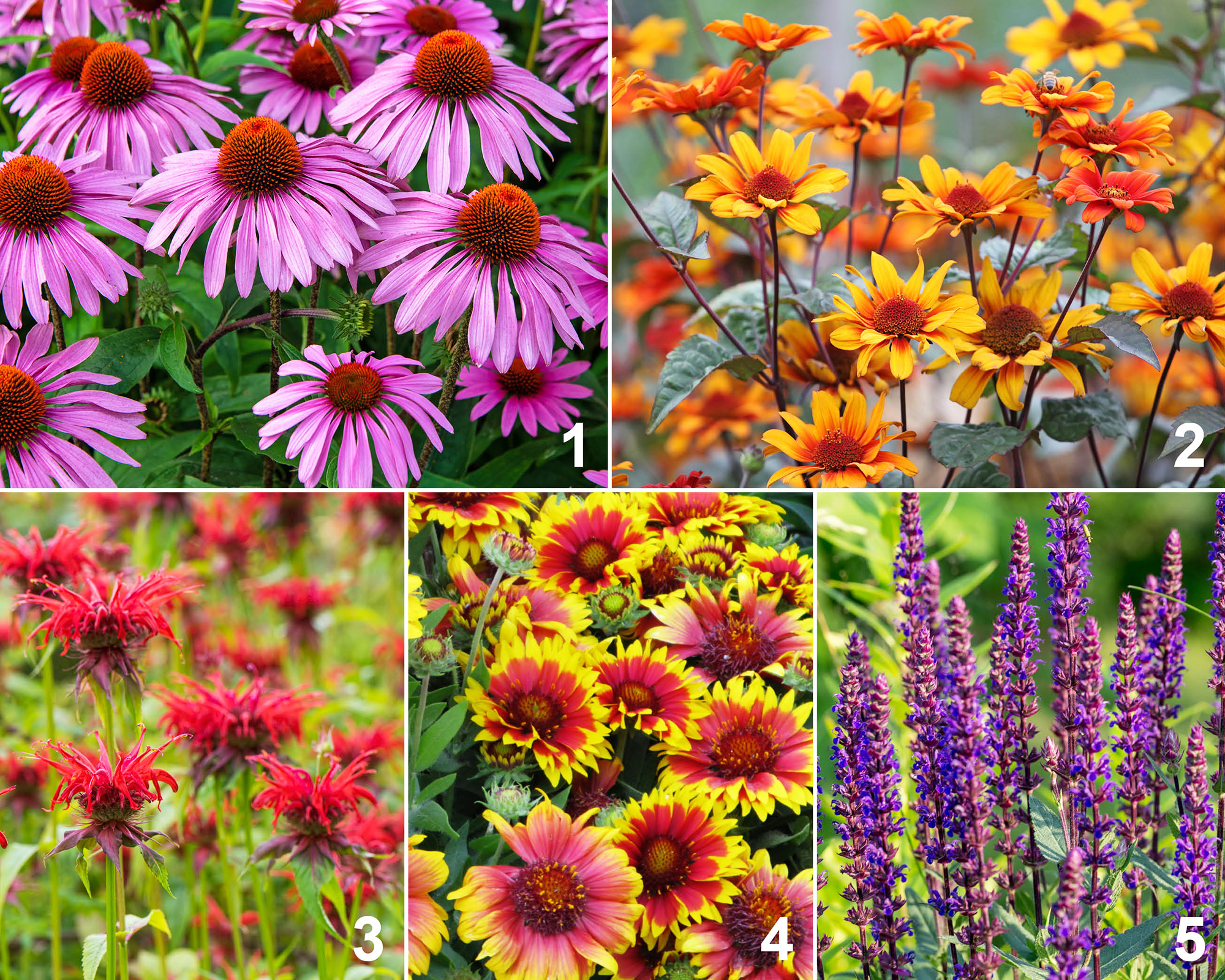5 Colorful Planting Recipes For Joyful Garden Beds And Containers
Transform your garden with these stunning plant combinations that will add bursts of vibrant color to beds and pots.


Plants serve so many different purposes. They can provide food for people and wildlife, offer cooling shade, block an unsightly structure, slow down and filter stormwater runoff, and help increase a property’s value. The most personal purpose, however, is to bring color and joy to a space that speaks to the gardener’s personality. Gardening with color is so very personal. Thankfully, nature has given us flowers in a never-ending palette to work with.
Creating a border brimming with vibrant and personal color is as simple as knowing what combinations of hues spark joy in your soul. That, and knowing your garden’s growing conditions.
When choosing plants for color, ensure they suit your USDA hardiness zone and can handle the light your garden receives (or doesn’t receive) each day, as well as its moisture levels. But when it comes to color, your own imagination is your only limitation.
For some, having so many colors and choices can be overwhelming. If that’s you, we’ve put together five different planting recipes that offer vibrant colors for gardens suiting several different themes and growing conditions. Our advice? Choose the color combos that make you smile the most.
1. Color in the Shade Garden

Shade gardens can be bright and colorful spaces thanks to cheerful flowers that thrive in low light. Any of these can be used individually for a bright surprise nestled in the shadows.
- Hydrangea 'Cherry Explosion' (Hydrangea macrophylla)
Usually known for blue to pink lacy blooms, Cherry Explosion takes hydrangea color into the red zone for a surprise in the shade. At 3-4 feet tall, this fits well in the middle of a large border planting. USDA zones 4-9. - Lamium ‘Orchid Frost’ (Lamium maculatum)
This low-growing ground cover adds a shimmer to the shade with dark green-edged silver leaves and violet-purple flowers. USDA zones 3-8. - Garden Phlox (Phlox paniculata)
This clumping, 2-4-feet-tall, slender stem is topped with elongated heads of colorful flowers in whites, pinks, reds, and purples. USDA zones 4-8. - Japanese Forest Grass (Hakonenchloa macra)
A grass for shade! Its 18-inch stature shines in chartreuse and yellow-greens, arching gracefully along the edge of a border. USDA zones 4-9. - Astilbe (Astilbe spp.)
Astilbe’s 1-2-foot-tall green-to-chocolate foliage produces 3-4-foot-tall spikes bearing beautiful plumes of color, from whites and pinks to reds and purples. USDA zones 3-8.
2. Pretty Pollinator-Friendly Perennials
Vibrant color serves a purpose in the garden, and that’s to attract pollinators. The following perennials are pollinator-friendly plants that pack a colorful punch.

- Coneflower (Echinacea purpurea)
Today’s cultivated varieties of this native plant come in a rainbow of colors. Why choose? An assortment of whites, reds, oranges, yellows, and purples brightens any full-sun border. USDA zones 3-9. - False Sunflower (Heliopsis helianthoides)
If you’re looking for a burst of sunshine yellow in your perennial garden, this is it! At 3-6 feet tall, false sunflower can live near the back of your garden border. USDA zones 3-9. - Bee Balm (Monarda spp.)
Bee balm’s clusters of tiny flowers come in a range of colors, from pink and lilac to dark red and cream. Bees are guaranteed! USDA zones 4-9. - Blanket Flower (Gaillardia x grandiflora)
The pinwheel-shaped flowers come in every hue of yellow, orange, and red. The 2-foot-tall pollinator favorite will be happy near the front of a garden bed. USDA zones 3-10. - Woodland Sage (Salvia nemerosa)
This perennial stuns with its vivid purple colors. The flower density is a show-stopper – and bees, butterflies, and hummingbirds love how it grows in masses. USDA zones 3-9.
3. Spring-Flowering Favorites

After a monotone winter season, spring-flowering blooms bring much-needed color to the garden. The following recipe offers color from early to late spring.
Sign up for the Gardening Know How newsletter today and receive a free copy of our e-book "How to Grow Delicious Tomatoes".
- Hellebore (Helleborus spp.)
Hellebores – or lenten roses – bloom anywhere from Christmas through very early spring. Rose-shaped blooms appear in whites, pinks, reds, and dark purples. Plant under deciduous shrubs for shade in the summer. USDA zones 3-9. - Dianthus (Dianthus spp.)
This bluish-leaved, low-growing, and clumping perennial – also known as pinks – is not only a garden favorite, but most varieties also have a heavenly fragrance. With a color palette spanning whites, creams, pinks to dark cherry reds color – in single to double flowers – it pops in the garden from mid-spring through summer. USDA zones 4-8. - Forsythia (Forsythia x intermedia.)
One of the first shrubs to bloom in early spring, it is unmistakable with its yellow highlighter vibrancy. USDA Zones 5-8. - Creeping Phlox (Phlox stolonifera)
This mid-spring flowering perennial creates thick, low mounds of color – whites to hot pinks, lavenders to deep purples. A fun plant for rock gardens and stonewall crevices. USDA zones 5-9. - Peony (Paeonia lactiflora)
This stately perennial with cup-shaped, single- to double-petaled flowers is a garden classic. The variety of colors and petal patterns is endless. USDA zones 3-8.
4. Annual Color in Containers

Add flower color quickly to any space with annuals in decorative containers. Plant individually in several pots or combine them in one or several larger containers.
- Dwarf Sunflowers (Helianthus annuus)
Dwarf varieties such as ‘Big Smile’ or ‘Firecracker’ are just 2-3 feet tall, perfect as a small-statured “thriller” in a mixed container. USDA zones 3-11. - Tuberous Begonia (Begonia x tuberhybrida)
These begonias excel in any spot where they can cascade out of a container. Place these in baskets under an eave or somewhat shaded spot on your patio. USDA zones 9-11. - Impatiens (Impatiens hybrids)
Impatiens come in an astounding array of colors, with their button-like flowers floating atop mounded leaves. Impatiens prefer partial shade, so use these in a darker corner of your patio or as the “spiller” plant in a larger combination. USDA zones 10-11. - Fuchsia (Fuchsia spp.)
Looking like a tutu-wearing ballerina, the brightly colored dangling flowers are often two-toned, providing multiple variations of color combinations. USDA zones 8-11. - Coleus (Plectranthus scutellarioides)
Not all color comes from flowers! From chartreuse and pink patterns to lime and maroon splotches and a multitude of leaf sizes and shapes, coleus is the star of foliar color for containers. USDA zones 10-11.
5. A Vibrant Single-Colored Garden

One color en masse can have an enormous impact. That’s the case with the Small Pink Flower Garden Kit by Plant By Number, available in the Gardening Know How Shop.
The garden kit transforms the front of a porch, a fence line, or the side of your home into a 7-foot-wide and 5-foot-deep partial sun garden into a cloud of pink blooms and lush foliage from spring through fall. It's ideal for USDA zones 6-8.
Each kit contains:
- Azalea 'Girard's Crimson' (Rhododendron sp.)
One vibrant, pink-flowered springtime azalea. - Sedum ‘Autumn Joy’ (Hylotelephium spectabile)
One sedum featuring a green-to-pink-to-maroon flower transformation over the course of the season. Butterflies and bees love this plant! - Astilbe ‘Visions’ (Astilbe spp.) One astilbe with raspberry-pink blooms as a summer-long accent plant.
- Pink Muhly Grass (Muhlenbergia capillaris)
One pink-plumed grass adds movement as well as color to the garden. - Coral Bells ‘Wild Rose’ (Heuchera sanguinea)
Three foliage-focused heuchera round out the kit with glowing dark rose-colored leaves and delicate pink blooms.
Other color-specific garden kits are also available, including Neon Lime, Jewel Tones, and Pastel Tones. Choose the kit and professionally designed color combinations that appeal to you the most – after all, this decision is personal.
This article features products available from third-party vendors on the Gardening Know How Shop.

Ellen Wells is a horticultural communications consultant with 30 years of experience writing about all aspects of the gardening world.
She has worked for many of horticulture’s biggest brand names, writing blog posts, articles, press releases, and design and instructional pieces. Her previous roles include Senior Editor and Editor-at-Large for Ball Publishing.
Ellen is based in New England where she gardens in Zone 7a. She loves tending to flower-filled containers on the patio and puttering around her vegetable garden.